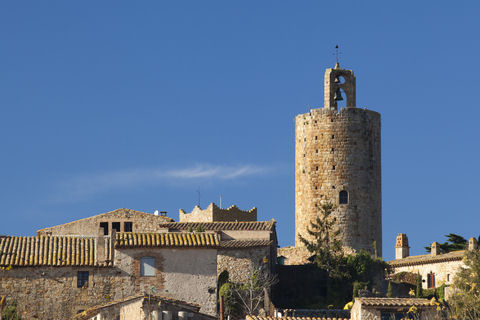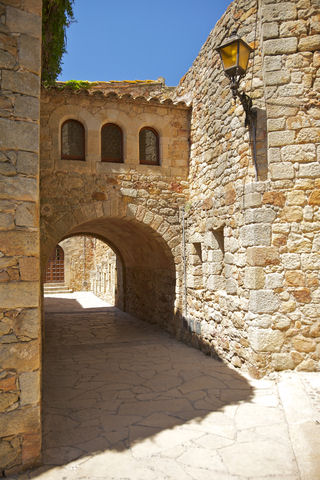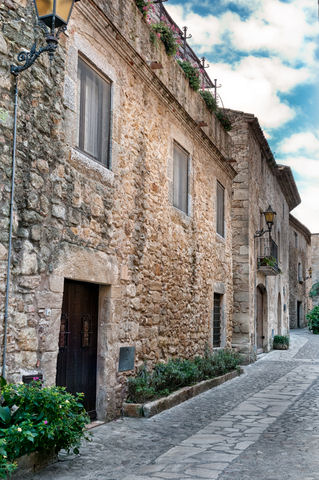The Costa Brava is considered by many visitors to be first and foremost a destination for beach holidays, which means that many overlook – or are completely unaware of – the history and rich cultural heritage of the region.

Settlements can be traced back to pre-Roman times and many towns have buildings dating back to mediaeval times that are in use today.
Two such towns are Pals and Peratallada, which have been considerably renovated and well worthwhile visiting for their narrow, picturesque streets and stone construction. The two towns are just six kilometres from each other and both can easily be seen in one day and the area is just a few kilometres from both the sea and a number of golf courses.
Pals

Pals lies just off the road between Palafrugell and Torroella de Mongrí (GI-650) with the Romanesque tower that stands on a hill seen as you approach the town. The tower, built between the 11th and 13th centuries, is known as the Torre de les Hores (Tower of the Hours).
The actual town name is derived from the Latin word for marsh, palus, thanks to the nearby wetlands. However, while Pals today is famous for the cultivation of rice, which is first documented in the 14th century, modern rice production dates from 1909. It was then reintroduced by Pere Coll i Rigau, a Catalan entrepreneur and farmer, after returning from Cuba where he made his fortune from manufacturing matches.
The town wall dates from the forth century and as well as the restored gothic quarter with its cobbled streets visitors should aim for the archaeology museum, the church of Sant Pere and the main street and square.
The wall was built to protect against pirate attacks, a common problem on the Costa Brava until the seventeenth century.
Peratallada
From Pals you can drive to Peratallada either along the GI-650 then turning off on the GI-651 (and I recommend stopping off in Palau-Sator for lunch at Mas Pou), or there is a more direct route, although the road winds more.

Declared a monument of historic and artistic merit, the narrow cobbled streets of Peratallada house small hotels, restaurants and galleries selling various artworks.
The village really is tiny; in 2005 there were just 222 inhabitants and it is unlikely that figure has changed too much since.
Here many buildings are built from carved stone – indeed, the name Peratallada is derived from pedra tallada, meaning carved stone – and surrounding the town is a moat carved into the stone.
In the centre of town is dominated by a privately owned castle and palace, while just outside the walls lies the 13th century church of Sant Esteve. The earliest written reference to the castle dates from 1065, although the exact origins of the town are uncertain.
What else to do
Fore anyone considering staying in or near Pals or Peratallada then another consideration may be what other activities are available to you. Mediaeval villages are all very well, but when the sun is blasting down in summer sometimes the only thing to do is head for the beach and cool off in the water, followed by a doze in the shade of a parasol.
Pals is a few kilometres inland from the sea, and Peratallada more so, with the roads to the beach getting rather busy in the second half of July and throughout August. That can make getting around rather a drag, but if you can endure sitting in traffic for part of the day then the area could be ideal to stay, depending on your interests and timing can make a big difference.
Several beaches are within driving distance, with the closest being the Platja de Pals, which lies at the southerly end of the long sandy beach that reaches up to Estartit.
It was here the tall radio masts used to beam the American broadcasts of Radio Liberty to Russia. The station went on air in 1959 and lasted until 2001 with the aim of broadcasting news and information to states that banned or controlled the free flow of information, although it has sometimes been accused of being a propaganda tool.
I remember visiting Estartit several times when I was in my teens and seeing the Radio Liberty antennae from the beach; however, they were destroyed in 2006.
Radio Free Europe/Radio Liberty continues to operate from other sites around the world to repressive regimes.
It is also a good area to visit as a golfer, with three golf courses in the immediate vicinity; Golf Platja de Pals, Golf Serres de Pals and Empordà Golf Club (and the Doubletree by Hilton hotel and spa).

